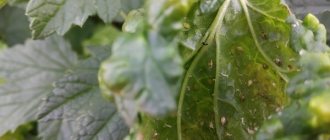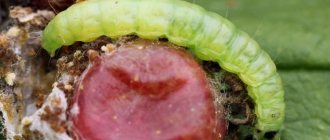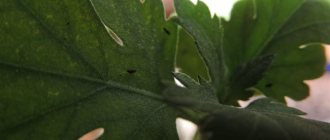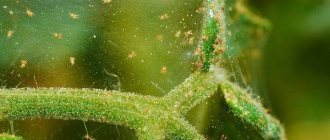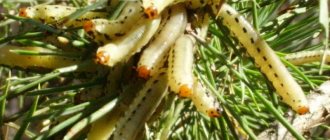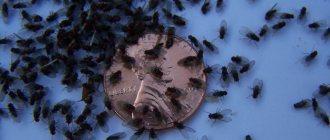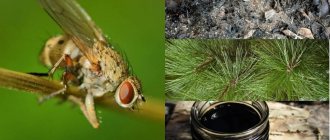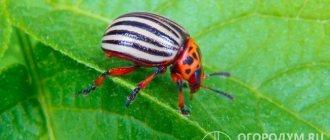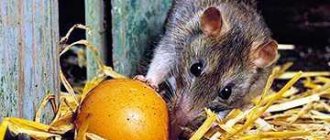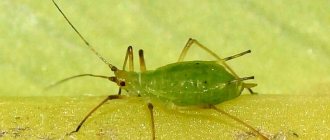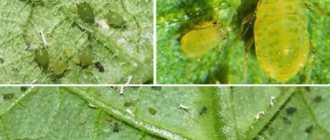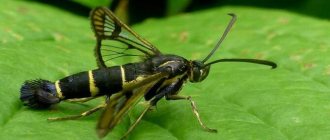Among insect pests that can cause serious harm to currants, aphids occupy a special place. These are small insects, whose colonies number thousands of individuals, are characterized by rapid and massive reproduction and voraciousness. Aphids feed on the juices of the currant bush, piercing leaves and young shoots with their proboscis. A large number of small insects can completely destroy a fruitful currant bush in a season. The danger of aphids also lies in the fact that they spread certain diseases.
Signs of defeat
You can determine that a currant bush is affected by aphids by some external signs. At first glance, this is quite difficult to do, since insect colonies are usually located on the back of the leaves. There are some indirect signs by which you can determine the presence of aphids:
- cessation of shoot growth;
- bending of branches;
- leaf deformation;
- a large number of dry branches;
- the formation of red swellings on the leaves;
- the presence of garden ants on currants.
Ants
Among all the negative signs, it is the appearance of garden ants on currant bushes that indicates the presence of gall or gooseberry aphids. The fact is that ants feed on the sweetish secretion that aphids secrete, so the ants take care of the insects, cultivate their colonies, and even transfer individuals to fresh, untouched bushes.
If small black ants appear in your garden plot, you should expect aphids to appear in the near future. The destruction of underground anthills plays an important role in the fight against aphids.
Curling leaves
Another characteristic sign of the presence of aphids on garden bushes will be the presence of leaves twisted into a tube. When insects suck the sap from the foliage, they damage the thin veins that hold the leaf open. When there are a large number of insects, the leaf is so damaged that it simply curls up. Unfortunately, many gardeners perceive leaf curling as a lack of minerals, and begin to actively feed currants, only aggravating the situation.
Plants that repel aphids
Owners of garden and summer cottages effectively use the insecticidal properties of plants. In addition to potatoes, tomatoes and celandine, flowers with a strong aroma can also repel insects. Therefore, it is necessary to plant marigolds, calendula, lavender, saffron, and chamomile around the currants.
Attention!
You can also sow yarrow and wormwood. If you don’t want to sow them, you can simply lay out their branches under a bush. Tomato tops and garlic leaves are also suitable for this purpose.
An excellent combination will come with onions, thyme, and garlic, which are planted near the bushes. When the black elderberry enters the flowering stage, its branches should be cut off and spread over the berry garden.
Solutions and infusions
Solutions and infusions based on plant components are very popular among gardeners. They are quite effective and completely safe for people and pets. The following strong-smelling substances are used from plants to prepare infusions:
- garlic;
- onion;
- garden horseradish;
- hot pepper;
- potato or tomato tops.
Garlic
There are two ways to prepare garlic infusion. In the first case, peeled garlic cloves are infused in cold water for at least three days. This must be done in a sealed container. For the second method, you need to grate a glass of garlic, fill it with cold water and leave for a day. The most important thing is that the liquid has a strong garlic smell. For greater effectiveness, garlic infusion is mixed with finely chopped laundry soap. A spray bottle is filled with this mixture and the leaves are treated with it. Soap glues insects together and prevents them from leaving the danger zone. Read how to get rid of aphids on cucumbers here.
The leaves should be sprayed from the back side, since aphid colonies are located there and spraying from above will not give a positive result.
Onion
To obtain onion infusion, you need to chop 40-60 grams of onions and pour two liters of water into it. Leave for at least five hours. Then add a little grated laundry soap. Apply branches and leaves using a spray bottle or a wide brush. This material will tell you about the use of onion peels for the garden.
Treatment with onion tincture should be carried out early in the morning or after sunset in calm weather. In case of high humidity and rainy weather, treatment is not carried out.
Potato
Potato tops need to be finely chopped and pour boiling water over them. The composition is infused for 24 hours and is used to spray currant bushes affected by aphids. It is recommended to add a little laundry soap to the infusion as a viscous substance that immobilizes aphids. Instead of potato tops, many gardeners use tomato greens.
Soda ash solution
Soda ash solution is an old and proven recipe against aphids.
The shell of insects is very thin and soda easily damages it, causing irritation and damage. Laundry or tar soap added to the solution prevents insects from moving and they die. The solution is prepared using one tablespoon of soda per liter of water.
You should not use scented toilet soap in solutions, as its smell can attract other insect pests.
Wood ash decoctions
Wood ash has long been used to control certain insects. 300-400 grams of ash should be sifted through a fine sieve to remove solid particles. The resulting powder is mixed with 1.5 liters of water and boiled for 30 minutes. After cooling, the mixture is filtered and water is added to it, up to 10 liters and two tablespoons of grated soap. In another option, 3 kg of ash is taken per 10 liters of water and the mixture is not boiled, but infused.
Treatment of bushes with a decoction of wood ash is carried out in any convenient way.
Tobacco infusion
Tobacco contains nicotine, which is a strong poison for aphids. To prepare the infusion, you can use dry tobacco or shag. 400 grams of dry product are poured with 10 liters of water and infused for two days, then the infusion is filtered, carefully squeezing out the grounds. To reduce the concentration, add another 10 liters of water to the infusion, and for viscosity, 80 grams of crushed soap. Currant bushes are sprayed with the solution early in the morning.
Prevention of aphids
It will take a lot of time and labor to fight this insect. To avoid infection of the bush, you will need:
- trim the bushes every year, getting rid of damaged shoots and branches;
- constantly remove weeds around the crop;
- dig up the soil under and around the plant;
- get rid of ants;
- plant plants that repel aphids;
- do not fight ladybugs and lacewings;
- In spring, pour boiling water over the bush.
In addition, branches and trunks should be whitened.
Traditional methods
To combat aphids on currants, there are many old and proven methods. They use strong-smelling or caustic liquids that are used in everyday life. Read about ammonia for aphids on currants here.
Birch tar and tar soap
Birch tar and products prepared from it have antimicrobial and antiseptic effects. Tar solution works well against aphids and other insects. 15-20 grams of tar and 50 grams of crushed laundry soap are dissolved in 10 liters of water. Currant bushes are sprayed with this mixture before and after flowering. You can also use tar soap for this purpose.
Vodka
Strong alcohol is a proven and reliable way to combat aphids. In the simplest version, ordinary vodka is poured into a spray bottle and the plants affected by aphids are treated with it. For a better effect, you can add two tablespoons of liquid soap to a bottle of vodka. It is better to use medical soap, as it does not contain fragrances. Instead of vodka, you can use a mixture of alcohol and water in a 1:1 ratio. The disadvantage of this method is the high cost of the original product.
Coca Cola
Despite the fact that carbonated drinks, particularly Coca-Cola, are food products, they are often and effectively used to control aphids. To do this, carbon dioxide is removed from the drink and diluted with water with the addition of tar or laundry soap. The treatment can also be carried out with a pure drink.
Phosphoric acid contained in Coca-Cola acts as an additional phosphorus supplement, which is why currants begin to develop better.
Apple vinegar
Apple or regular vinegar is available in every kitchen and can be used to kill aphids on currants. Acetic acid is not used in its pure form or in high concentration, as it can burn leaves and young shoots. If vinegar essence is available, then 4 teaspoons per bucket of water will be enough. Table vinegar is added in the amount of 10 teaspoons per bucket, and apple cider vinegar is diluted in the ratio of 1 tablespoon per liter of water.
Ammonia
Ammonia is sold in any pharmacy and is a very effective remedy against garden aphids. To avoid damaging the plants, the ammonia solution must be diluted with water. For 10 liters of water, 50 ml of ammonia is enough. You need to add a little laundry soap or washing powder to the prepared solution. You need to spray currants once every 10 days. Due to the rapid evaporation of the active component, the solution should be prepared immediately before use. To treat currant bushes, it is better to use a watering can rather than a spray bottle.
Boiling water treatment
Spring treatment with boiling water allows you to solve several problems at once. Very hot water can destroy almost all pests that wake up after hibernation in the spring. This treatment destroys the most dangerous pests - aphids and bud mites. Currant bushes should be watered with boiling water in early spring, when sap flow and buds have not begun to bloom.
Laundry soap
Laundry or tar soap is included in various infusions and solutions that are used to combat aphids. But the soap itself has a strong insecticidal effect. Aphids are reliably killed by caproic acid, which is part of the soap. The soap solution is very easy to prepare. To do this, dissolve 300 grams of crushed soap in two liters of warm water. When the soap is completely dissolved, the liquid concentrate must be diluted with 8 liters of cold water, after which the solution must be filtered.
Milk and whey
To combat aphids, you can use a milk-iodine mixture. You need to take 200 grams of warm milk and add 1 ml of alcohol iodine tincture. The components are mixed and the infected bushes are sprayed through a spray bottle. You can also use whey for this purpose.
Proponents of organic gardening use only natural products to control insects.
Celandine
The juice of this plant contains active substances that are toxic to all types of aphids. To obtain an infusion, you can use all parts of the plant:
- leaves;
- flowers;
- roots;
- stems.
Everything needs to be finely chopped and poured with warm water at the rate of 4 kg of fresh celandine per bucket of water. The mixture should stand in a dark and warm place for at least three hours. When the infusion acquires a dark brown color, it can be used to combat aphids.
Mustard
To obtain mustard infusion, you need to dilute 100 grams of mustard powder in 10 liters of water. The solution is infused for 24 hours, after which it is mixed with another 10 liters of water, in which 50 grams of laundry soap are dissolved. Treatment of currants and other fruit trees is carried out two weeks after flowering.
Periods when treatments are carried out
Aphids constantly parasitize currant bushes. But there are periods when she is especially active. Let's find out when currants need special protection from insects. We will tell you what control methods should be used depending on the growing season of currants.
During flowering
In the Moscow region and central Russia, currants bloom in mid-May. At this time, aphid larvae hatched in the spring are already beginning to mature, and therefore it is easier to deal with them: adult individuals are most susceptible to folk methods of combating them. There are no restrictions in the choice of recipes at this time, since the fruits on the bush have not yet set.
After flowering
Aphids can infect currants even after flowering has ended, when the first berries have already formed . Treatments in this case will be very effective, since all the individuals are already adults, and they have not yet had time to lay eggs. But during this period it is advisable to abandon the use of celandine, which can partially be preserved in the fruits. The juice of this plant is poisonous to humans.
During berry ripening
During the period of filling the berries, aphids are less active. She is preparing for reproduction, because if she does not have time to lay eggs, the currant shoots will become coarse. But this does not prevent the fight against the pest. However, the products used should not be toxic, have a persistent odor or a burning taste, as they can be preserved in the berries. Therefore, do not use red pepper, birch tar and celandine.
During fruiting
By the beginning of fruiting, most of the aphids have already laid eggs and moved to neighboring plants, including garden and vegetable crops. Therefore, it is advisable to process not only currants, but also other bushes. To ensure that the products used do not affect the taste and aroma of the berries, they should be tasteless and odorless. At this time, it is better to use boric acid, Coca-Cola, soda or vodka, which disappears very quickly.
When the leaves bloomed
Adult aphids lay eggs under the tender bark of annual currant shoots. There they spend the winter. In the spring, when the leaves begin to bloom, larvae emerge from them and feed on the sap of young leaves. At this time, plants especially need protection, since the larvae are very voracious and can cause serious damage, leaving you without berries.
Chemicals
Chemicals are very effective against aphids and other pests, but unlike plant components, they are quite toxic to people and pets.
Fufanon
This is a modern insecticide whose active ingredient is malathion. The drug is available in ampoules, in the form of a concentrated emulsion of 2 and 10 ml. The contents are diluted in a small amount of water and after complete dissolution, mixed with 10 liters of water. Currants should be sprayed early in the morning or after sunset. The harvest can be harvested no earlier than three weeks after the last spraying.
Aktara
The drug has a strong impregnating effect, so it becomes fatal to all insect pests that feed on plant sap. "Aktara" can persist in plant tissues for up to 60 days. The insecticide belongs to class III and is moderately dangerous at a concentration of 0.02%. The drug is available in granules, suspension or liquid form.
In order to avoid poisoning, harvesting should be done 30 days after treatment.
Intavir
"Intavir" is an effective drug that destroys a wide range of pests. The drug is not used for prophylaxis due to its high toxicity. It is available in tablets and powder form. The components are dissolved in water according to the instructions.
If the composition is stored for a long time and sediment forms in it, it is useless to use.
Boric acid
Boric acid is useless against aphids, but it effectively kills ants that contribute to the spread of aphids. To do this, boric acid powder is mixed with powdered sugar and scattered on ant paths. Find out how to treat cherries against aphids from this article.
Copper sulfate
Copper sulfate in its pure form and as part of Bordeaux mixture is an inexpensive and most common chemical used to kill pests. To spray currants, use a 1% or 3% solution of copper sulfate in water.
Spraying with copper sulfate is carried out regularly and ends a month before harvest.
Dichlorvos
"Dichlorvos" has proven itself in the destruction of various insects. It is available in aerosol packaging, which makes it convenient to use in any conditions. When processing currants, do not place the sprayer too close to the young leaves so as not to damage them.
Potassium permangantsovka
Potassium permanganate is not considered an active drug against aphids, but it can provide some assistance in the fight against insects. A small amount of potassium permanganate is dissolved until it turns pink, and then the solution is diluted in 10 liters of water.
Karbofos
This is an organophosphorus drug in chemical composition and spectrum of action similar to dichlorvos. When working with this insecticide, precautions should be taken.
What is the danger of aphids for currants?
Aphids pierce young leaves and feed on their sap. As a result, the leaf plate is deformed, red-brown swellings form on it, which leads to its drying out and death.
There is another type of insect that feeds on the sap of shoots, which interferes with their growth. Due to the fact that young shoots of the bush are affected, summer residents may be left without berries this year and next.
Parasites will not be able to destroy the bush, but it will wither, weaken and bear almost no fruit. In addition, pests are carriers of various viruses that cause diseases.
Biological products
These drugs are prepared using components such as bacteria, fungi and other substances of biological origin. They are absolutely safe and their only drawback is that they act too slowly.
Fitoverm
To destroy aphids on currant bushes, you need to dilute the drug with water in a ratio of 2: 1000. Fitoverm can be used once every 20 days. Individuals of garden aphids begin to die after approximately 72 hours.
Entobacterin
This biological product is toxic to many types of harmful insects. To effectively combat aphids, it should be diluted with water at the rate of 10 grams of powder per 1 liter of water. It is better to treat currants against aphids at an air temperature of + 250C and above. In this case, the maximum effect is expected. The bushes must be treated at least twice with an interval of 7 days.
Arrow
"Strela" has a delayed duration of action, and the result appears after 10-15 days. A standard package of 50 grams is diluted in 10 liters of water. With a large number of aphids, the concentration can be increased.
You can pick berries two days after treating the bushes with Strela.
30-plus
The drug is available in containers of 250 and 500 ml. The insecticide is diluted in 5 and 10 liters of water, respectively. The solution remains active for only two hours, so it must be diluted immediately before use.
Tanrek
"Tanrek" is active for many types of insects, including bees, so it cannot be used during flowering. The drug is absorbed into the leaves and affects aphids as they feed on plant sap. The drug should not be used in sunny weather, as it can burn the leaves.
Confidor
The drug remains active in any weather and allows you to cope with the massive spread of aphids.
"Confidor" is available in the form of an emulsion and a water-soluble concentrate.
There are more active versions of the drug - these are “Confidor Maxi” and “Confidor Extra”
Biotlin
This drug works well not only against aphids, but also against garden ants, which are distributors of these pests. The concentrated solution in ampoules is very economical. By dissolving one 3 ml ampoule in 10 liters of water, you can treat 7-8 currant bushes. This link will tell you how to fight aphids on pear trees.
What do aphids look like on currants?
There are more than 4 thousand species of aphids in their natural habitat. BUT in summer cottages only leaf gall and gooseberry are found. The first affects red and white currants, and the second affects black currants.
This insect reproduces quickly, so it destroys more plants. In one season, a colony of parasites can destroy a medium-sized shrub - it will be greatly weakened and will not be able to survive the winter.
An adult insect does not exceed 2 mm in length and can be light green, yellow-green or gray-green.
Description of the pest
As a rule, this type of parasite concentrates on the lower part of the leaf. The tops of the shoots are affected. The leaves begin to curl. Most often, ants also live near aphids, so you will have to fight them too.
If you do not take any action, the currant leaves will dry out and fall off. So curled leaves should be removed and burned immediately.
Treatment of bushes against aphids is carried out mainly in the spring. It will also be useful to learn about how to protect currants from ants and aphids.
